- Joined
- Jul 12, 2004
- Messages
- 4,060
WOW!!! What can I say, I am just really pleased with the results. This is SO much better than I could have ever imagined. Too bad I didn't find PS, Wink, and Richard earlier as this ring hasn't been worn for at least 7 years.
Richard, thank you for your extraordinary artistry. You are truly a master cutter.
Wink, thanks for the referral (and the gentle nudge to just do it).
Boy, I am surrounded by GGs. Maybe its time for me to just complete the 3 required extension lab classes and get my GG (I am just a lowly GIA Gemologist when I obtained my diploma from the GIA in 1989 via their Distance Education Dept). Hey, if I ever win the CA Lottery, I would quit my job as an IT Consultant and work in the jewelry business instead.
Okay, here is the technical stuff from an email I received from Richard:
Everyone will be pleased to hear that the Sapphire recut was VERY successful. The gem was CONSIDERABLY improved in both beauty and value all the while diminishing face-up appearances of color zoning, excessive extinction, and reflective inclusions. My original estimation of weight loss was right on as well....20% with no loss in girdle dimensions....finished weight = 2.55ct.
It is interesting to note that the original native cutter supposed incorrectly that, by virtue of the gem's medium dark tone, he had to keep a massive amount of pavilion depth to retain the quality of color.
As you can see in my microscope view of the pavilion, there is a large colorless color zone in the culet area. In my recut, I removed nearly a millimeter of that unnecessary colorless area to lay in facets that would properly reflect and blend the color banding that you see in this image. The net result is a more homogenous face-up color and one that is actually a bit more saturate. The gem's face-up color appears a bit darker in the image comparison but this is due mostly to the difference in lighting (note the backgrounds). The face-up color of the recut WAS improved and deepened in color by virtue of having closed the 30% window of the native cut...the true key color remains and is enhanced in the recut.
It is truly a glorious gem now! And, now I think, truly worth the money that was paid for it. ( Wink, as a qualified appraiser, can judge for himself.) In the images, you can see as well, that I retained a goodly portion of the original pavilion bulge so that the color zoning could be best utilized and the resultant gem still nicely fit back into the original ring mounting without having to modify the gold.
Edited to say: Thanks to Jennifer5973 for the Photoshop help. I have been programming mainframe computers for more than 20 years, yet don't know how to use Photoshop. That's sad

Here are the face up pictures.
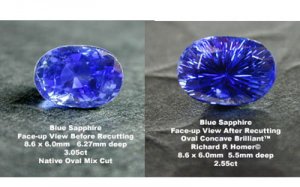
Richard, thank you for your extraordinary artistry. You are truly a master cutter.
Wink, thanks for the referral (and the gentle nudge to just do it).
Boy, I am surrounded by GGs. Maybe its time for me to just complete the 3 required extension lab classes and get my GG (I am just a lowly GIA Gemologist when I obtained my diploma from the GIA in 1989 via their Distance Education Dept). Hey, if I ever win the CA Lottery, I would quit my job as an IT Consultant and work in the jewelry business instead.
Okay, here is the technical stuff from an email I received from Richard:
Everyone will be pleased to hear that the Sapphire recut was VERY successful. The gem was CONSIDERABLY improved in both beauty and value all the while diminishing face-up appearances of color zoning, excessive extinction, and reflective inclusions. My original estimation of weight loss was right on as well....20% with no loss in girdle dimensions....finished weight = 2.55ct.
It is interesting to note that the original native cutter supposed incorrectly that, by virtue of the gem's medium dark tone, he had to keep a massive amount of pavilion depth to retain the quality of color.
As you can see in my microscope view of the pavilion, there is a large colorless color zone in the culet area. In my recut, I removed nearly a millimeter of that unnecessary colorless area to lay in facets that would properly reflect and blend the color banding that you see in this image. The net result is a more homogenous face-up color and one that is actually a bit more saturate. The gem's face-up color appears a bit darker in the image comparison but this is due mostly to the difference in lighting (note the backgrounds). The face-up color of the recut WAS improved and deepened in color by virtue of having closed the 30% window of the native cut...the true key color remains and is enhanced in the recut.
It is truly a glorious gem now! And, now I think, truly worth the money that was paid for it. ( Wink, as a qualified appraiser, can judge for himself.) In the images, you can see as well, that I retained a goodly portion of the original pavilion bulge so that the color zoning could be best utilized and the resultant gem still nicely fit back into the original ring mounting without having to modify the gold.
Edited to say: Thanks to Jennifer5973 for the Photoshop help. I have been programming mainframe computers for more than 20 years, yet don't know how to use Photoshop. That's sad

Here are the face up pictures.






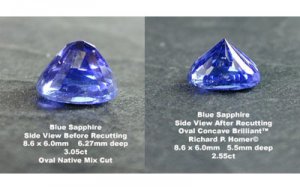
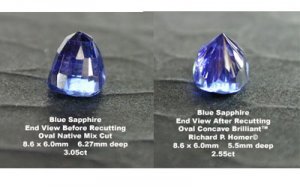














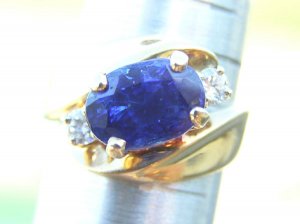
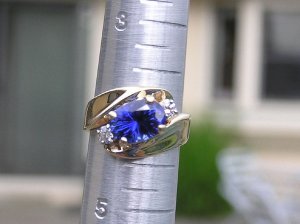
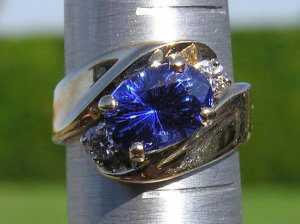
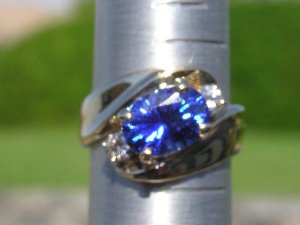
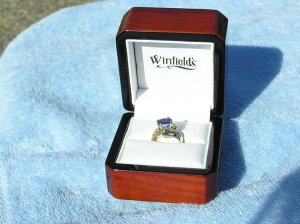



300x240.png)